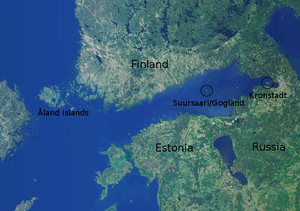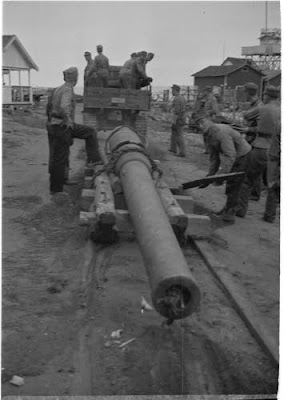In April 1938, the Soviets contacted the Finns, stating that they didn't trust Nazi Germany and wanted guarantees that Finland would not be used for the German attack on the USSR. In March 1939, the Soviets asked Finland to lease Suursaari and four small uninhabited islets for thirty years, and cede rich and heavily populated areas on the Karelian isthmus, saying that they were vital for the defense of Leningrad, the second biggest Soviet city. In return, the Soviet Union offered a large slice of empty and unofficially disputed Karelian borderland in exchange. The Finns refused.
Soviet forces had occupied Gogland during the Winter War, and, under the terms of the Moscow Peace Treaty, Finland was forced to cede the island to the Soviet Union. As Operation Barbarossa commenced, the Soviets placed a garrison on the island; however, as invading German forces on the mainland moved closer to Leningrad, the Soviet command ordered the evacuation of most of the islands in the Gulf of Finland, as well as their besieged base at Hanko on the Finnish coast.
Soviet forces left the islands of Gogland, Sommers and Bolshoy Tyuters on 7–9 December 1941. Finnish coastal forces noticed that the islands had been abandoned, and manned both Gogland and Sommers with small garrisons by December 12.
Poor ice conditions and harsh weather made it difficult for the Finns to reinforce the garrisons, and when Soviet forces returned in company strength on January 2, 1942, the surprised Finns had to withdraw from Gogland
Attack Troops on the way to the island, led by a horse sleighs
Grenade Launcher on the sea ice
antiaircraft sea ice
Determined to retake Gogland, the Finns concentrated a three battalion strong force to the nearby Haapasaaret Islands, which are roughly 20 km NNE of Gogland. Finnish forces were under command of Major General Aaro Pajari and consisted of the second battalion of the 6th Infantry Regiment, or II/JR 6, and the first battalion of the 27th Infantry Regiment, or I/JR 27, and the whole of the 2nd Coastal Battalion (RP 2) supported by the mortar and anti-tank gun companies of the 6th Infantry Regiment, 3rd company of the 23rd Engineer Battalion, 1st Battalion of the 19th Field Artillery Regiment (total of 12 guns), and two artillery batteries (total of 8 guns).
The strength of the Soviet garrison was roughly 500 men but it lacked artillery, which meant that the garrison had to fight without support, while the Finns had artillery and air support.
| Battle of Suursaari | |||||||
|---|---|---|---|---|---|---|---|
| Part of the Continuation War | |||||||
 Location of Gogland | |||||||
| |||||||
| Belligerents | |||||||
| Commanders and leaders | |||||||
| Aaro Pajari | |||||||
| Strength | |||||||
| Gogland: 518 men | ||||||
| Casualties and losses | |||||||
| Gogland: 63 dead or missing, 109 wounded | Gogland: ~300 dead, 36 POW, on the island alone | ||||||
Suursaaren strateginen sijainti - Suursaari strategic location. Miinakentät/Minefields
Mine Line over the Gulf of Finland
Mine Line over the Gulf of Finland
Vuosina 1938–1939 Neuvostoliitto lähetti Suomelle useita nootteja, joissa vaadittiin Suomelta tukikohtia ja alueluovutuksia. Suursaari, joka hallitsee meriväylää Pietariin, kuului aluevaatimuksiin. Lokakuussa 1939, kun sodan uhka oli jo tuntuva, koko väestö evakuoitiin nopeasti. Kaikki saaren 772 henkikirjoilla ollutta ihmistä joutui evakkoon. Siviilien omaisuudesta saatiin evakuoitua vain osa. Muun muassa hylkeenpyyntiin jalostettuja koiria saatiin mantereelle vain muutamia.
Talvisodan alettua Neuvostoliiton ilmavoimat hyökkäsivät saarelle 1. joulukuuta 1939. Saaren pieni, muutaman kymmenen hengen vartiosto katsoi parhaaksi seurata asukkaiden esimerkkiä ja lähteä saarelta. Samana iltana neuvostojoukot nousivat saarella maihin ja valtasivat tyhjän saaren 3. – 4. joulukuuta 1939 laivaston ankaran pommituksen ja tykkitulen tukemana. Sodan päättäneessä Moskovan rauhassa 1940 Suursaaresta tuli Neuvostoliiton aluetta. Talvisodassa kolme suursaarelaista kaatui.
Jatkosodassa neuvostojoukot lähtivät saarelta joulukuussa 1941, minkä jälkeen suomalaisjoukot ottivat sen haltuunsa. Suomalaiset pysyivät saarella muutaman kuukauden ja vetäytyivät tammikuussa 1942, kun parin sadan sotilaan vahvuinen neuvostoliittolaisosasto hyökkäsi saarelle. Valtauksen yhteydessä kuoli kuusi kalastajaa, jotka olivat palanneet koteihinsa Suurkylään. Valtauksen jälkeen operatiivinen tilanne Itä-Suomenlahdella muuttui Neuvostoliiton eduksi. Kun jäät lähtisivät, sen laivastoyksiköt voisivat käyttää Suursaarta tukikohtanaan, mikä aiheuttaisi vaikeuksia Suomen rannikkopuolustukselle sekä uhkaisi Saksan ja Suomen toteuttamaa Suomenlahden sulkua.
 Helmikuussa 1942 Suomen sodanjohto päätti vallata saaren takaisin ennen kuin neuvostoliittolaiset ehtisivät linnoittaa saaren. Suursaaren valtaus valmisteltiin erittäin huolellisesti etukäteen. 26. maaliskuuta noin prikaatin vahvuiset, ilmavoimien ja tykistön tukemat suomalaisjoukot ryhmittyivät Suomenlahden jäälle ja valtasivat saaren noin pataljoonan vahvuisilta neuvostojoukoilta kahden päivän kiivaiden taistelujen jälkeen. Venäläisten tappiot Suursaaren taistelussa olivat noin 250 sotilasta kaatuneina ja vankeina.
Helmikuussa 1942 Suomen sodanjohto päätti vallata saaren takaisin ennen kuin neuvostoliittolaiset ehtisivät linnoittaa saaren. Suursaaren valtaus valmisteltiin erittäin huolellisesti etukäteen. 26. maaliskuuta noin prikaatin vahvuiset, ilmavoimien ja tykistön tukemat suomalaisjoukot ryhmittyivät Suomenlahden jäälle ja valtasivat saaren noin pataljoonan vahvuisilta neuvostojoukoilta kahden päivän kiivaiden taistelujen jälkeen. Venäläisten tappiot Suursaaren taistelussa olivat noin 250 sotilasta kaatuneina ja vankeina.
Suomalaisten tappiot olivat 170 sotilasta kaatuneina ja haavoittuneina.
Sodan loppuvuosina Suursaarta linnoitettiin voimakkaasti. Rantakallioille valettiin tykkilavetteja ja luolia räjäytettiin varastoiksi sekä väestönsuojiksi – demilitarisoinnista ei ollut enää puhettakaan. Saari toimi suomalaisten laskeman miinasulun yhtenä tukipisteenä.
Nimellä ”Rukajärvi” tunnettu merimiinojen ketju ulottui Haapasaaresta Suursaaren ja Tytärsaaren kautta Kurkolanniemeen (Viron puolella).
---------
first canteen building
General Aaro Pajari come down to the cannon tower
June 24 mid-summer celebration time
6-inch Canet gun gunfire
June 24 mid-summer celebration time
May 30, 1942, the first field canteen opened
large-island / groß-insel communications ship
----------
Suomen ja Neuvostoliiton solmiessa aselevon syyskuun alussa 1944 Saksan joukot olivat vetäytyneet Virossa Narvan tasalle. Suomen vetäytyminen sodasta avasi Neuvostoliiton laivastolle vapaan kulkutien Itämerelle.
Jotta neuvostolaivaston liikkeitä voitaisiin rajoittaa, saksalaiset päättivät miehittää Suursaaren. Tätä varten oli jo aiemmin laadittu suunnitelma, koodinimeltään oli Tanne Ost. Aamuyöllä 15. syyskuuta 1944 Suurkylän lähelle ilmestyi kymmenkunta saksalaisalusta. Suomalais- ja saksalaiskomentajien välillä lienee käyty keskustelu, jossa Saksa ilmoitti halunsa ottaa saaren haltuun rauhallisin keinoin.
Kun suomalaiset eivät suostuneet, syttyi taistelu, joka loppui myöhään samana iltana saksalaisten menetettyä kymmenkunta alusta ja noin 1 400 sotilasta kaatuneina, haavoittuneina ja vankeina. Suomalaisten tappiot olivat noin sata sotilasta. Taistelun aikana suomalaiset saivat voimakasta ilmatukea Neuvostoliiton ilmavoimilta. Taistelussa saadut saksalaiset sotavangit jätettiin rauhansopimuksen mukaisesti Neuvostoliitolle. Moskovan välirauhassa Suomi luopui Suursaaresta, mikä vahvistettiin lopullisesti Pariisin rauhassa vuonna 1947.
Prior to the attack Finnish forces opened two roads over the ice to the island's vicinity. Assault troops rode in trucks as far as they could, then, in the pre-dawn hours of March 27, traveled the last five kilometers over the packed ice on skis. Finnish forces were split into two groups: Detachment Sotisaari, containing the bulk of the forces, which approached the island from the west, and the three company strong Detachment Miettinen, which was to pin down Soviet defenders on the eastern side of the island. The Finnish plan called for the regular infantry battalions to spearhead the assault, with coastal troops held in reserve.At 0400 on 27 March 1942 Finnish artillery began bombarding known Soviet strongpoints on Gogland. II/JR 6 reached the island without meeting opposition; I/JR 27, however, met determined resistance as it neared its planned entry point, and quickly switched to the same route used by the other battalion. Finnish forces successfully overcame most of the Soviet defenders and captured key locations on the island. Fatigue from the long march to the island, enemy resistance, and difficult terrain forced the Finns to halt their assault at 2200, at which time the only remaining Soviet strongpoints were in the extreme southern and northern tips of the island.
During the night some of the Soviet forces still on the island chose to flee over the ice. The Finns resumed clearing the island the next morning. In many cases, defending Soviet forces refused to surrender and put up very stiff resistance, forcing the Finns to use satchel charges on Soviet positions. The last remaining Soviet strongpoints were taken on the morning of 29 March. Small numbers of Soviet troops escaped over the ice towards Moshchny Island (Finnish: Lavansaari), though the fleeing men suffered losses from repeated strafing runs by Finnish Air Force fighters.
Air activity was high on both sides. On March 27–28 Finnish Air Force Fokker D.XXI, Curtiss P-36 Hawk and Brewster F2A Buffalo fighters claimed a total of 27 Soviet Polikarpov I-153 and Polikarpov I-16 fighters. Air forces on both sides supported their ground forces with strafing and bombing runs, the Finns using twin engined Bristol Blenheim and Tupolev SB-2 bombers.
island hospital
Lieutenant Colonel Fullgrabe visiting captain and adjutant Laaksonen action
More German visitors (1942 summer)
broken cannon
catch soviet ambulance
Last snowbank on the island 05/26/1942
Soviet post office
Soviets are demolish a stone-church and makes the horse stables, and is also used by the church roof again...
...icluding the church bell to get a new role.
Marx and Engels
Russian mine mooring cable switch-torpedo (tow)
On March 30, 1942, with Gogland secured, the Finns sent a small patrol to investigate Bolshoy Tyuters. A strong Soviet garrison forced the patrol to depart. A stronger force was sent to capture the island on April 1, and by the time the company-sized force reached the island the Russians had abandoned it. On the following day the Russians returned, and despite Finnish resistance, managed to create strongpoints on the island. With German support, Finnish troops eventually managed to destroy or drive off the remaining Soviets
On April 8, 1942, after the Germans had transported artillery to the Bolshoy Tyuters, the Soviets launched another attack. The assault force was estimated to have been roughly 1,200 men strong, but the heavy German artillery on the island and lack of cover on the frozen Gulf of Finland caused heavy casualties among the Soviets.
Suursaari was especially important because it worked as a lock in the Finnish Gulf guarding the minefields keeping the Soviet Baltic Fleet in Kronstadt.
-------------------------------------------------------------------------------

























































Ei kommentteja:
Lähetä kommentti
Any explosive ammunition or empty cores, you can put in this.